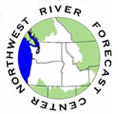
 |
HEC-RAS - The NWRFC recently completed calibrations and implementation of the NWS FLDWAV model on the Lower Columbia, Coquille at Coquille, and Umpqua at Reedsport and backwater conditions along the Kootenai River near Bonner's Ferry. Work continues in the area of the lower Snohomish and lower Skagit Rivers. All of these implementation sites will be transitioned to a HEC-RAS model. The Corps of Engineers HEC-RAS is a generalized unsteady-flow open channel simulation model. This model has a wide range of applications, including effects of backwater conditions, levees, tidal off-channel storage, dams, bridges, wind shear effects, sinuous channel structure, and sub and super critical flows. New developments in modeling systems will allow for these sites to be included into a long-range ensemble model. This will provide forecasts beyond the current ten day limit. CHPS - The National Weather Service is modernizing its river forecasting operations to accommodate advances in hydrologic science from the public and private research community. The Community Hydrologic Prediction System (CHPS) is under way to take advantage of Service Oriented Architecture (SOA) to speed development and research to operations process. The NWRFC is one of four river centers in the country involved with test and evaluation of this system in an operational environment. With this focus, the RFC should be ready to utilize the new techniques sometime in the fall of 2010. Calibration - Improvement of hydrologic models is an on-going process. In 2003, the first RFC hydrologic model calibration was completed. This expanded the forecast capabilities from less than 100 forecast points to over 360. It also provided continuous year-around streamflow forecasts and long-range probabilistic streamflow predictions. A second round of calibrations is under way. This is a joint effort of the NWRFC, Bonneville Power Administration and Riverside Technology, Inc. About 60 % of the RFC area has gone through re-calibration using hydrologic data through 2003. GFE and Grids - The National Weather Service over the last several years has move the basic forecast system from points to a grid system. With the implementation of CHPS, the NWS hydrologic Community is making the transition to this grid based system. The NWRFC has led the river centers in utilization of the Gridded Forecast Editor (GFE) tool with in operations. GFE allows the forecaster to examine different model inputs, pick parts from all, blend and adjust grid points and areas, check validity of different layers, and share grids with neighboring sites for collaboration purposes. The larger domains of the river center areas have posed many challenges for current computer capabilities. There are studies are addressing the errors and bias between the point and gridded approach. Development of a gridded historical record is being considered for use in future calibrations. Initial results are expected in 2011. ASWS - The NWRFC is implementing an advanced statistical water supply forecast system. This system consists of many components designed to improve the regressional statistical water supply forecasts. We have improved on data collection, estimation, quality control, and statistical analysis. Updates to the equations are nearing completion. Testing and verification is in the second year of evaluation. A determination to switch to ASWS will be made at the end of this seasonal water supply season (2010). |
